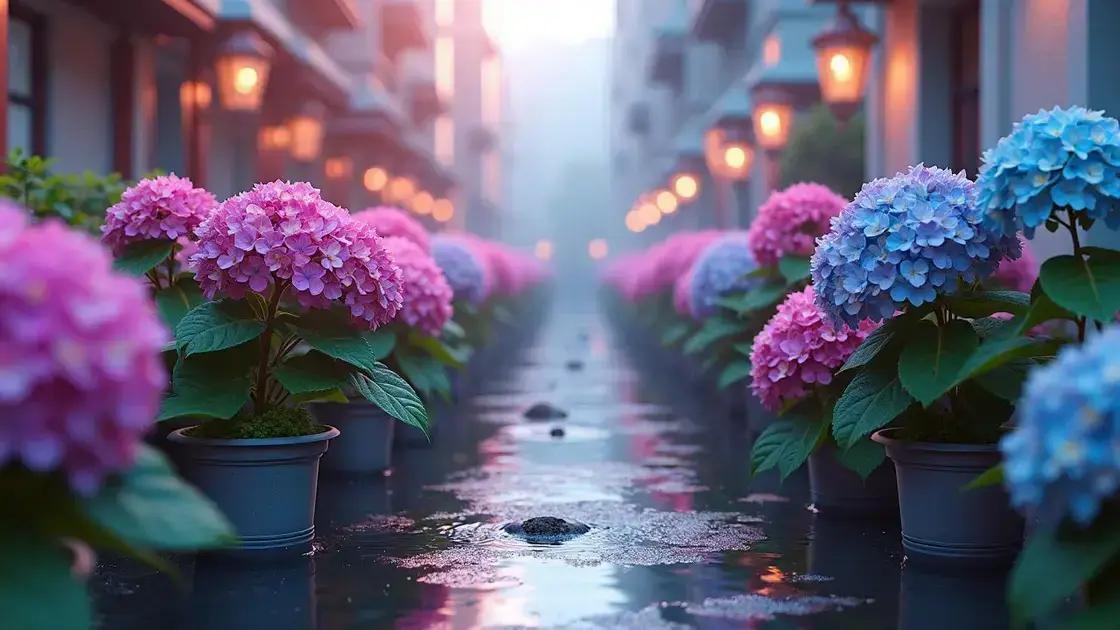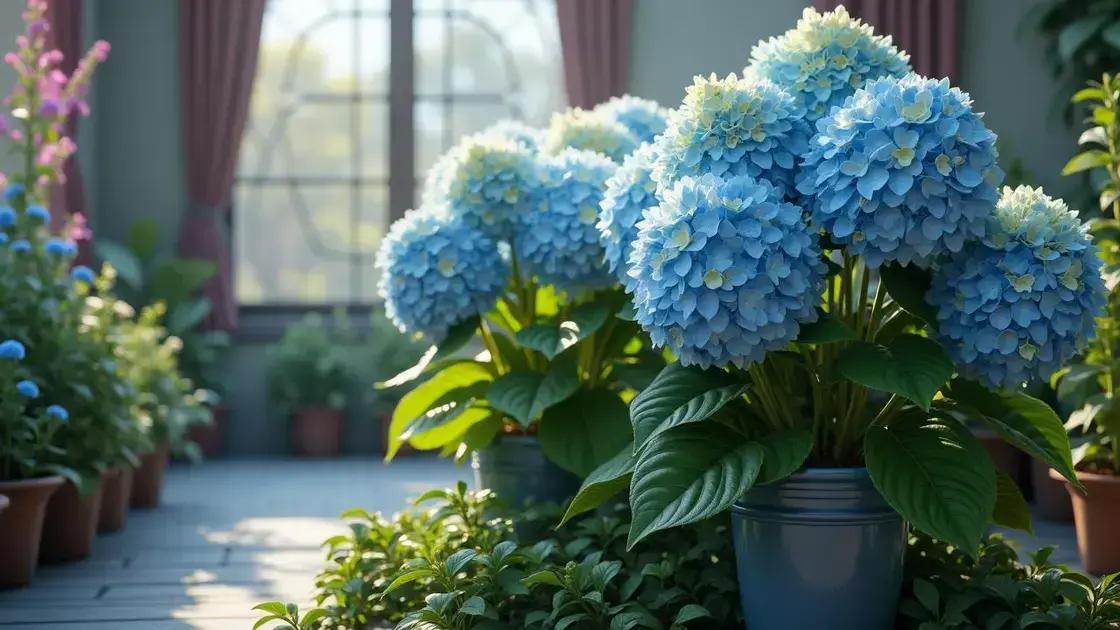How to Care for Hydrangea Plants in Pot: 5 Essential Tips for Success
How to care for hydrangea plants in pot is a question many aspiring gardeners ask. With vibrant blooms and their breathtaking beauty, hydrangeas are a popular choice for container gardening. Understanding their needs can turn anyone into a successful hydrangea caretaker. Let’s dive into the essentials that will transform your potted hydrangeas into stunning displays.
Table of Contents
ToggleEssential tips for potting hydrangea plants
How to care for hydrangea plants in pot starts with choosing the right container and soil. Proper potting is crucial for the health and vibrancy of your hydrangea plants. This guide will provide essential tips to set you on the path to success.
Choosing the right pot size
- Start with a pot that is at least 12-16 inches in diameter for young plants.
- Ensure the pot has drainage holes to prevent water stagnation.
- Consider larger pots for mature hydrangeas to accommodate root growth.
Using quality potting soil
Choosing the right potting mix is essential. Hydrangeas thrive in rich, well-draining soil. Look for a mix that contains:
- Organic matter, like compost or peat moss, to retain moisture.
- Perlite or vermiculite to enhance drainage.
- Aphid-resistant ingredients to protect against pests.
Watering techniques for potted hydrangeas
Proper watering is key when exploring indoor gardening techniques. Here’s how to do it effectively:
- Check the top inch of the soil; if it’s dry, it’s time to water.
- Water thoroughly until it drains from the bottom holes.
- Avoid overhead watering to prevent leaf rot.
Fertilizing container hydrangeas
Feeding your hydrangeas appropriately can ensure vibrant blooms. Use:
- A balanced slow-release fertilizer every six weeks during the growing season.
- A water-soluble fertilizer if you’re seeking faster results.
- Adjust fertilizer types for the specific variety of hydrangea you are growing.
Repotting for growth
Repot your hydrangeas every two years to refresh the soil and space. During repotting:
- Gently loosen the root ball before placing it in the new pot.
- Add fresh soil and bury the plant at the same depth.
- Ensure it is well-watered after repotting to encourage rooting.
Maintaining hydrangea plants
Regular maintenance is critical for the health of your hydrangeas:
- Prune spent blooms to encourage new growth.
- Monitor for pests, treating them promptly to avoid infestations.
- Adjust sunlight exposure as needed, ensuring they receive bright, indirect light.
Watering techniques for potted hydrangeas

Watering techniques for potted hydrangeas are vital for ensuring their health and stunning blooms. Understanding how to provide the right moisture will keep your hydrangea plants thriving in their containers. Here, we will explore effective methods to water your potted hydrangeas properly.
Assessing soil moisture levels
Before watering your hydrangeas, it’s important to check the soil moisture:
- Stick your finger about an inch into the soil. If it feels dry, it’s time to water.
- A moisture meter can give you precise readings, helping you avoid overwatering.
Timing your watering
Watering at the right time is crucial for potted hydrangeas:
- Water early in the morning or late afternoon to prevent evaporation.
- During hot summer days, consider watering twice a day for adequate moisture.
- Avoid watering in the evening to prevent fungal diseases from excess moisture overnight.
Techniques for effective watering
Implementing the following techniques will ensure your plants get the right amount of water:
- Water slowly and thoroughly, allowing it to soak into the soil rather than running off.
- Use a watering can with a spout or a soaker hose for controlled watering.
- Consider bottom watering by placing the pot in a basin of water for a short period to let the soil absorb moisture.
Signs of overwatering
Recognizing overwatering is crucial for potted hydrangeas:
- Yellowing leaves or wilting can indicate root rot due to excess moisture.
- Check for a foul smell from the soil, which is a sign of root decay.
- Remove any dead or mushy roots if you catch root rot early.
Improving moisture retention
Enhance moisture retention in the potting mix to help your hydrangeas:
- Incorporate organic matter like compost to improve soil structure.
- Add mulch to the surface of the soil to reduce evaporation.
- Use self-watering pots to maintain consistent moisture levels without frequent checks.
For more insights on proper plant care, exploring indoor gardening techniques can be beneficial.
Understanding hydrangea sunlight requirements
Understanding hydrangea sunlight requirements is essential for growing these beautiful plants successfully in pots. Proper exposure to sunlight directly influences the health, growth, and bloom quality of your hydrangeas. Let’s explore the optimal lighting conditions you need to provide for your potted hydrangeas to thrive.
Optimal sunlight conditions
- Most hydrangea varieties prefer partial shade, especially during the hottest part of the day.
- Morning sun with afternoon shade is ideal for many popular types like the bigleaf hydrangea.
- Provide at least 4-6 hours of indirect sunlight daily for optimal growth.
Identifying sunlight preferences by type
Different hydrangea types have varying sunlight requirements:
| Hydrangea Type | Sunlight Preference |
|---|---|
| Bigleaf Hydrangea (Hydrangea macrophylla) | Morning sun, afternoon shade |
| PeeGee Hydrangea (Hydrangea paniculata) | Full sun |
| Oakleaf Hydrangea (Hydrangea quercifolia) | Partial shade |
Signs of inadequate sunlight
Recognizing signs of improper sunlight exposure will help you address issues promptly:
- Leggy growth with sparse leaves indicates too little light.
- Burned leaf edges suggest excessive direct sunlight.
- Reduced blooms or no flowers at all can be due to inadequate sunlight.
Adjusting for seasonal changes
As seasons change, so do sunlight conditions:
- In summer, shielding your plants from harsh afternoon rays can prevent stress.
- In winter, ensure your indoor hydrangeas get enough light due to shorter days.
To dive deeper into nurturing your hydrangeas, exploring indoor gardening techniques can provide additional insights.
In conclusion
Caring for hydrangea plants in pot requires a thoughtful approach to potting, watering, and understanding their sunlight requirements. By implementing the essential tips discussed, you can create a thriving environment for these beautiful plants. Remember, proper potting techniques and consistent care will lead to vibrant blooms, enhancing the beauty of your home or garden. For more insights and tips on enhancing your indoor garden, continue exploring reliable gardening resources.

